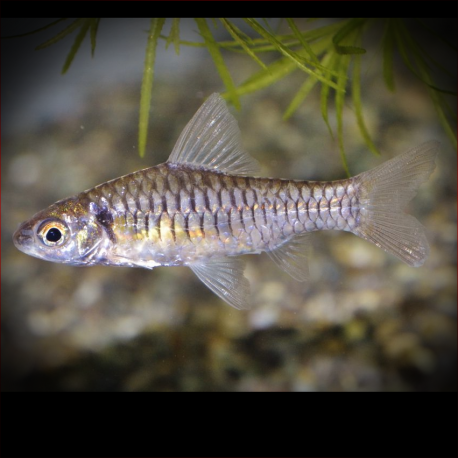More info
Datasheet
| Minimum Tank Size | 80 litres / 21.13 US gallons |
| Maximum Size | 6.0cm / 2.36inches |
| Temperature | 22°C / 71.60°F - 26°C / 78.80°F |
| Hardness | 2.02dgH / 36ppm - 10.03dgH / 179ppm |
| pH | 6.0-7.0 |
General Description
The Congo Barb (Clypeobarbus Congicus) is a relatively peaceful species within the Cyprinidae family, reaching a maximum size of 6.0cm. This species, native to parts of the Congo River drainage in the Republic of Congo and the Democratic Republic of Congo, was reclassified in 2008, previously believed to be a member of the genus 'Barbus.'
Aquarium Setup
To ensure the well-being of the Congo Barb, a tank of a minimum of 80 litres is essential. It is crucial to maintain a setup that includes heavy planting, dark substrate, floating vegetation to diffuse lighting, and additional decor such as driftwood roots, rocks, and leaf litter. Water conditions within the tank should have a hardness of 36-179ppm, pH between 6.0-7.0, and a temperature range of 22-26°C. For detailed information, please refer to the specifications in the table provided.
Behaviour
Known for their gregarious nature, Congo Barbs exhibit shoaling behavior rather than schooling. They thrive best when kept in groups of 8 or more to establish a pecking order among males. Adequate space and decor that provide broken lines of sight are essential to prevent weaker individuals from being bullied. When alone or in cramped conditions, they may become nervous and withdrawn.
Feeding and Diet
Being omnivorous, Congo Barbs feed on small aquatic invertebrates, micro-organisms, and algae in their natural habitat. In captivity, they readily accept high-quality flake or pelleted food and enjoy small live or frozen treats like Artemia, Daphnia, and bloodworms.
Reproduction & Dimorphism
Although specifics on aquaria reproduction are limited, it is presumed that Congo Barbs are egg-scattering fish. Successful breeding involves conditioning the fish in a separate tank, selecting suitable pairs for the spawning tank, and providing optimal water conditions. Males display brighter colors, while gravid females are noticeably rounder-bodied.
Habitat and Distribution
While specific habitat data is unavailable, these barbs likely inhabit tributaries and smaller rivers in the Congo River drainage. Native to the Republic of Congo and the Democratic Republic of Congo, Congo Barbs were initially found near the coastal port towns of Boma and Matadi.
Ensure proper care and attention to replicate their natural habitat and social needs when keeping Congo Barbs in an aquarium setup.

